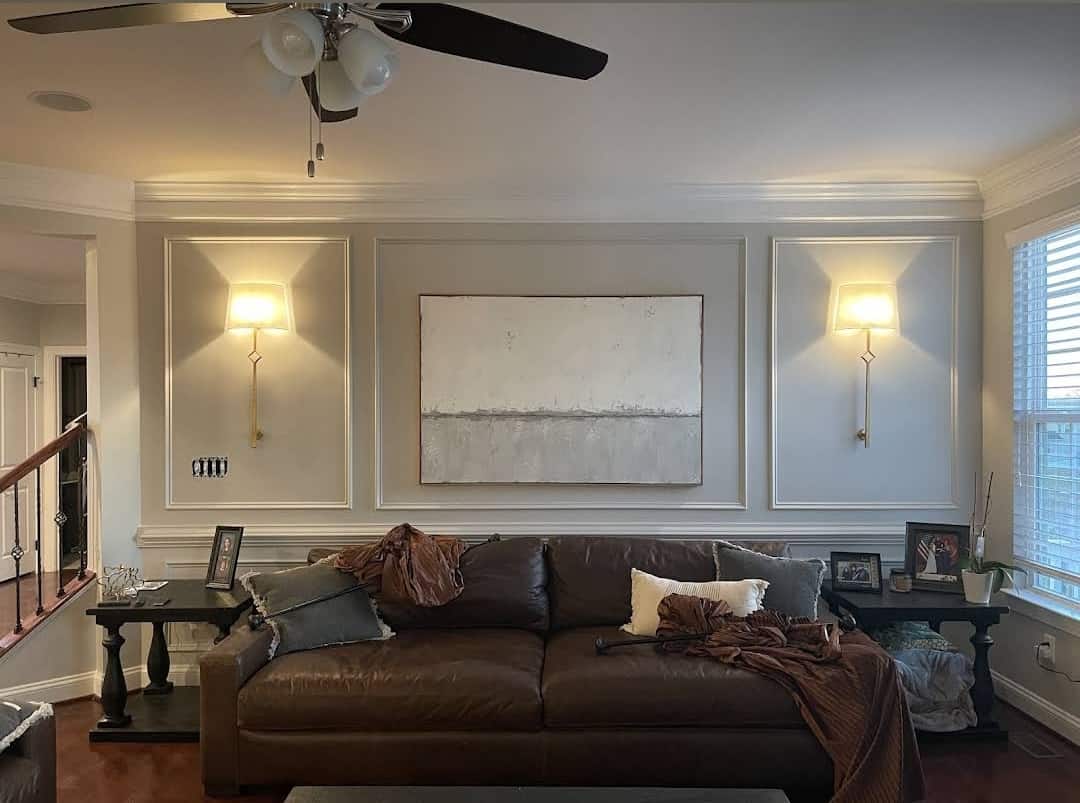Painting your walls can be a bit of a guessing game. If you’re in McLean, VA, you’re probably standing there with a paint roller, asking yourself, How many coats of paint for interior walls do I need? One coat, two coats, maybe three?
These are common questions. Many homeowners end up either applying too many coats, wasting time and paint, or stopping too soon, only to be left with uneven patches. The truth is, finding that sweet spot depends on a few important factors. This guide will help you break it down, so you can get the flawless finish for your interior house painting project.
Key Takeaways:
- This blog helps homeowners decide how many coats of paint for interior walls are needed for a smooth, lasting finish.
- It explores factors like wall color, paint quality, wall condition, and the importance of using primer.
- Provides practical tips to avoid over-painting and achieve a professional-looking result every time.

The Golden Rule: Two Coats Usually Does It
Generally speaking, two coats of paint are the standard for most interior walls. This number offers the best blend of coverage, durability, and color richness. Two coats not only even out the color but also help the paint adhere properly to the wall. However, the magic number can change depending on what you’re working with. Some walls and paints need a bit more attention to get things just right.
Key Factors That Determine How Many Coats of Paint for Interior Walls
Here’s the nitty-gritty. The number of paint coats you’ll need depends on several factors. Let’s explore each one to help you decide what’s right for your project.
1. The Color You’re Painting Over
The existing wall color plays a huge role. If you’re covering a light wall with another light shade, one or two coats will usually be enough. But if you’re switching from a darker shade to a lighter one, it’s a different story. In Vienna, VA, homes often have earth tones and deep accent walls. If you’re painting over a rich burgundy with a soft cream, expect to need two, maybe three coats, to get full coverage.
2. The Quality of Your Paint
Using high-quality paint can change the game. Premium paints are often thicker and contain more pigment, which means they can cover surfaces better with fewer coats. Some brands advertise “one-coat coverage,” but even with these, two coats are often recommended for the best look. On the other hand, budget paints might need three coats to achieve a smooth, uniform finish. Understanding the different types of interior paint and investing in quality paint upfront can save you time and effort in the long run.
3. Condition of the Walls
Before you paint, take a close look at your walls. If they’re in good shape—smooth, clean, and free of imperfections—you’ll probably need fewer coats. However, if you’re dealing with dents, stains, or patchy spots, be ready to add an extra layer. In homes where walls may have seen years of wear and tear, it’s crucial to address these issues with a good primer and multiple coats for the best results.
4. The Importance of Primer
Primer is like the secret sauce for painting. If you’re changing the color of your walls drastically or covering up stains, using a primer will make all the difference. It helps to smooth out the surface and creates a base that allows the paint to adhere better. Most of the time, one coat of primer followed by two coats of paint will give you the perfect finish. Skipping this step could mean you’ll need to add more coats later, costing you time and money.
5. Type of Paint Finish
Flat paints generally need fewer coats because they offer more coverage. But if you’re using a glossy finish, like semi-gloss or satin, you might need an extra coat or two. These finishes reflect light, which can make imperfections more noticeable, so they require more paint to look smooth and even. High-traffic areas like kitchens and bathrooms often use glossier paints for easy cleaning. Keep that in mind when planning how many coats you’ll need.
6. Your Desired Look and Effect
If you’re going for a bold color or a high-end look, don’t skimp on the coats. Deep colors like navy or emerald green usually benefit from three coats to achieve that rich, vibrant appearance. For a luxurious finish that looks professionally done, taking the time to add an extra coat can make all the difference.
Is One Coat Ever Enough?
Sure, there are times when one coat can work. If you’re refreshing a wall with the same color and it’s in decent shape, one coat might do the trick. The same goes for some high-quality paints labeled as “one-coat coverage,” but even then, it’s not always guaranteed. It’s best to have enough paint on hand in case a second coat is needed to get that smooth, even look.
Painting Over Textured Walls
Textured walls present their own set of challenges. If your Alexandria, VA home features textured surfaces, expect to need more paint. The texture creates peaks and valleys that require more coverage. Plan for at least two coats, but don’t be surprised if you need a third to get a uniform finish.
Avoiding Overdoing It
While it’s tempting to keep adding more paint for a perfect look, overdoing it can backfire. Too many coats can result in a thick, gummy finish that’s prone to peeling. Stick with two coats as your starting point, let each layer dry completely, and add more only if you still see inconsistencies.
Final Thoughts
So, how many coats of paint for interior walls is just right? In most cases, two coats will give you the even, vibrant finish you’re after. However, factors like wall color, paint quality, wall condition, and your desired effect might lead you to add a third coat. A fresh, well-painted interior can transform a room’s look and feel. If you’re unsure about how many coats to use, consulting a professional painting service like JC Custom Painting LLC can save you time and give you peace of mind.
Ready to tackle your next painting project? Call us at 571-575-6818 for a FREE estimate and get started on your home’s new look today!

